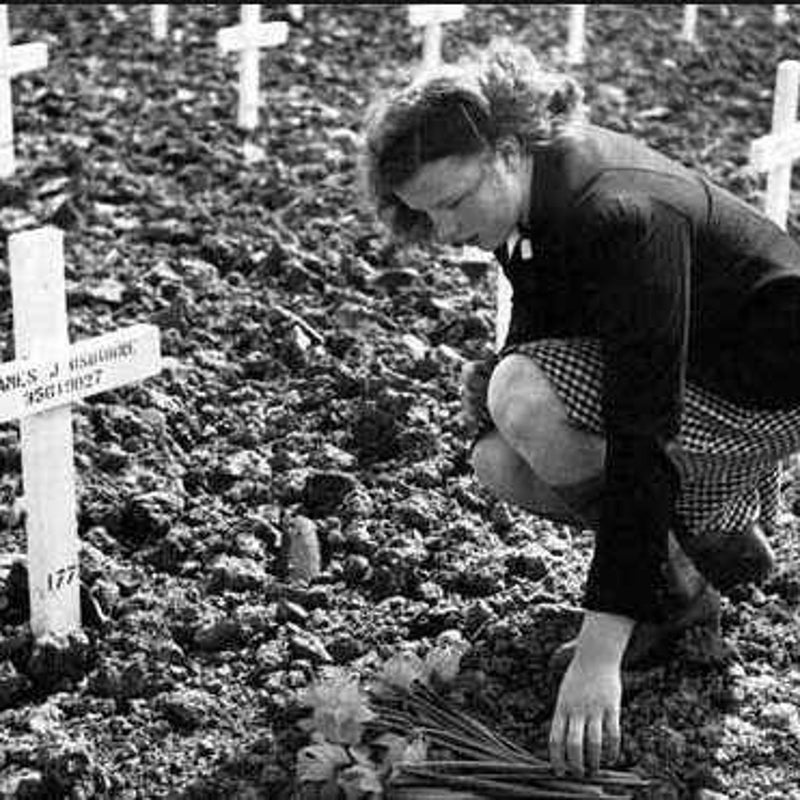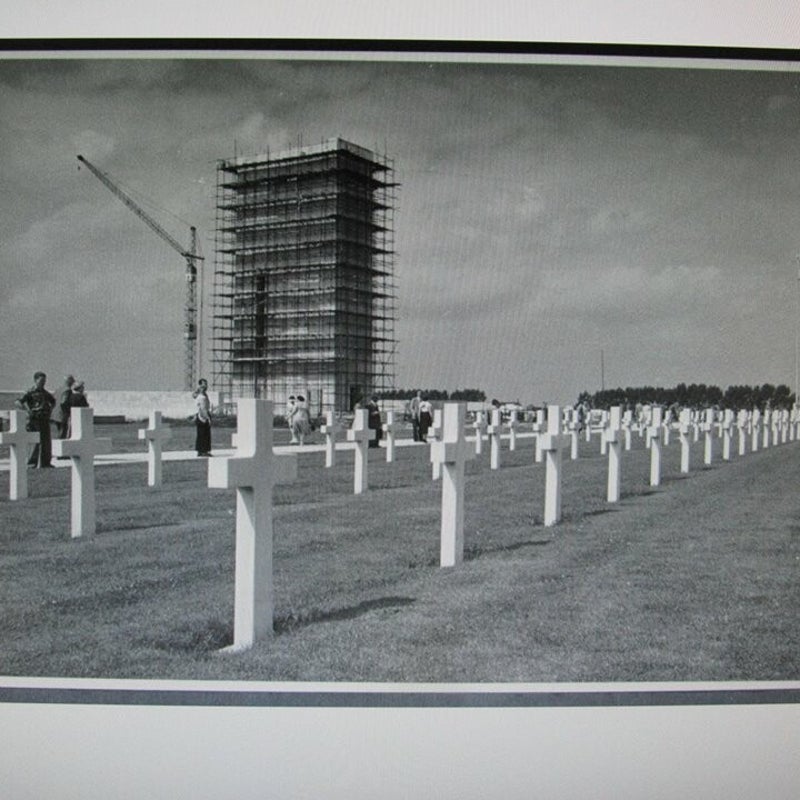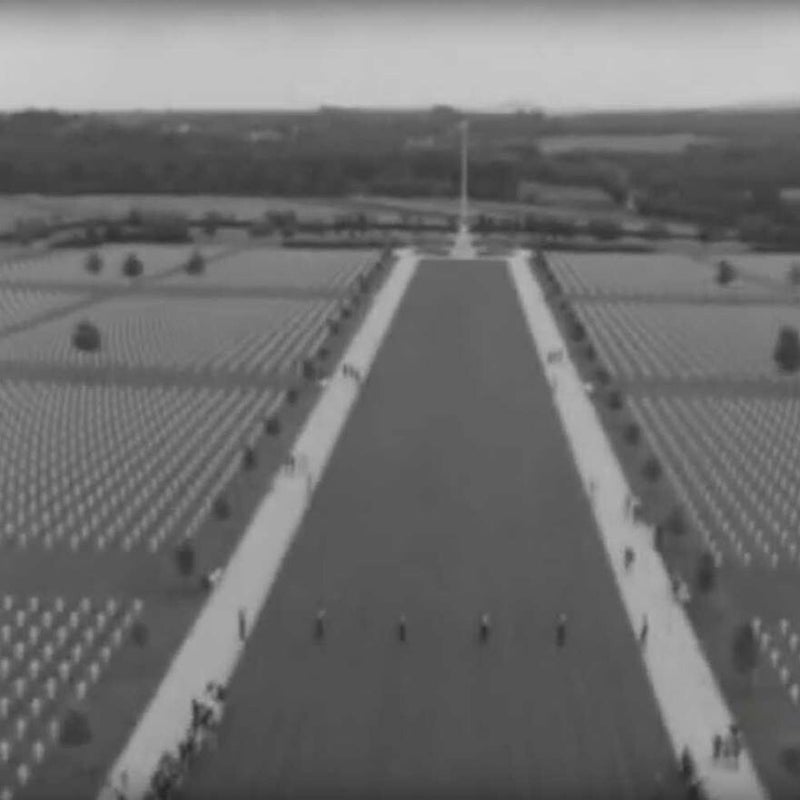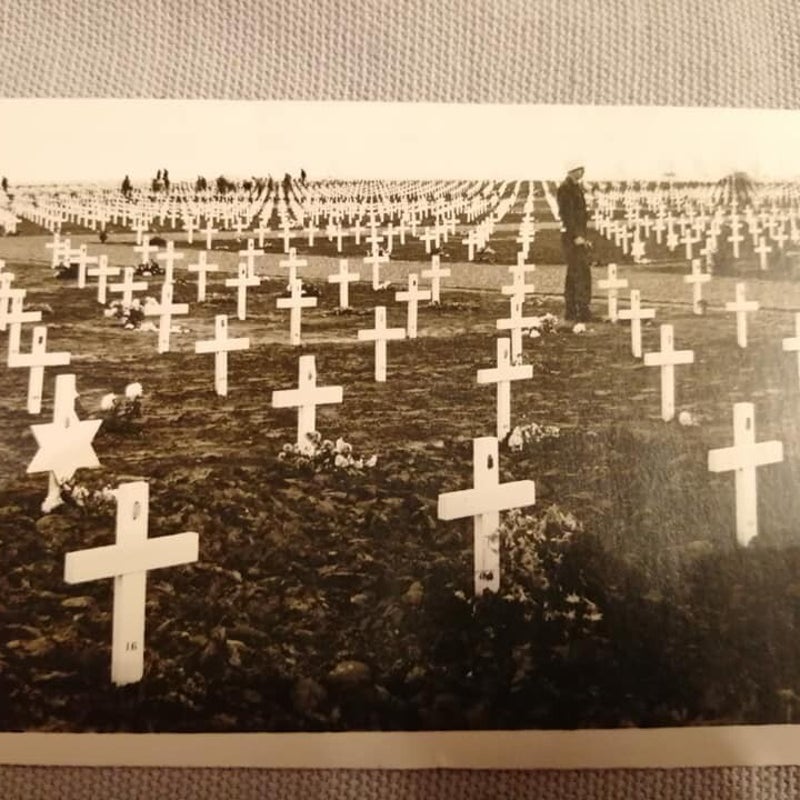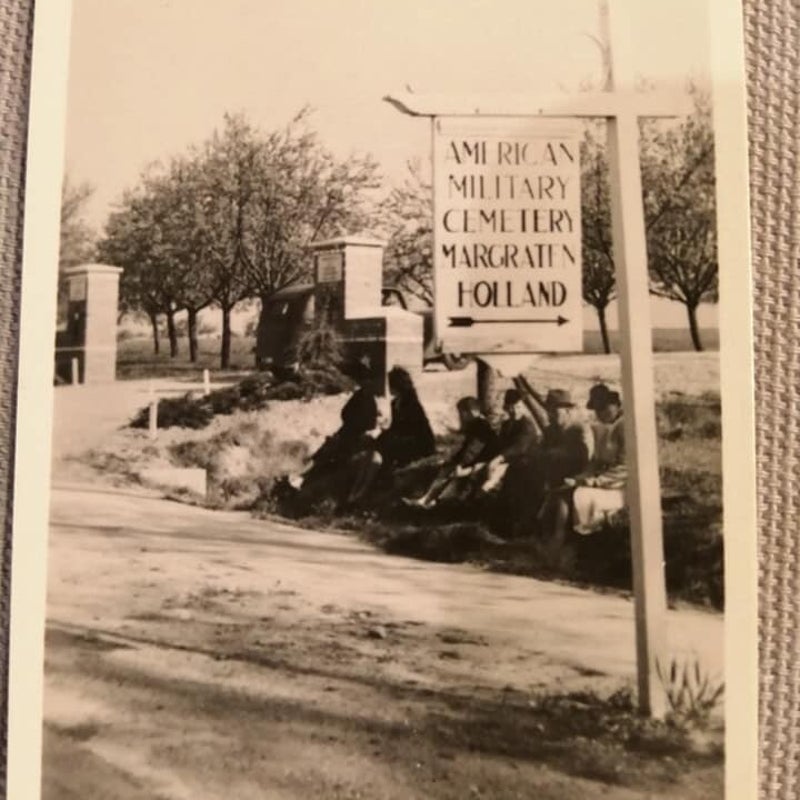AMERICAN CEMETERY MARGRATEN
The Netherlands American Cemetery and Memorial is the only American military cemetery in the Netherlands. The cemetery site has a rich historical background, lying near the famous Cologne-Boulogne highway built by the Romans and used by Caesar during his campaign in that area. The highway was also used by Charlemagne, Charles V, Napoleon, and Kaiser Wilhelm II. In May 1940 Hitler's legions advanced over the route of the old Roman highway, overwhelming the Low Countries. In September 1944, German troops once more used the highway for their withdrawal from the countries occupied for four years.

hree months after the successful Allied landing on the beaches of Normandy on June 6, 1944 - D-Day - the Allied troops had made great progress in conquering Luxembourg and Belgium and entering the Netherlands. The liberation of Limburg and the subsequent in Germany were imminent. The German army began to stabilize its defenses around the Siegfried Line on the western border of Germany.
The leadership of the US 9th Army assumed that many people would be killed in the attacks on the Rur and Rhine (Crossing the Rhine) and the advance to Berlin. Because no American soldier is buried in German soil, it was decided in October 1944 to set up an American cemetery in South Limburg.
On the orders of Major James McCormick of the Quartermaster Section of the US 9th Army, Captain Joseph Shomon, commander of 611 Graves Registration Company (611 GRC) knocked on the door of Margraten town hall.
His request to set up an American cemetery in an agricultural area west of Margraten was granted by the mayor. Later, the Dutch government gave the land - over 26 hectares - on loan to the American government forever.
The infrastructure construction of the cemetery was carried out by 172 Engineer Combat Batallion. The entire process of identifying and burying the dead was in the hands of 611 GRC, under the command of Major McCormick. Day-to-day management was in the hands of Captain Joseph Shomon, commander of 611 GRC. T
he cemetery was opened on 10 November 1944. Much of the work - laying out the tombs, stripping the corpses of clothing and personal belongings, and moving and burying the corpses - was done by men from 960 Quartermaster Service Company (960 QSC) and from mid-December by men from 3136 QSC. These units consisted almost entirely of African American soldiers. Only officers were white.

On March 1945 +500 dead were delivered pro day to margraten.
After the war on March 1946, all US graves in Germany were cleared and taken to Margraten. After all graves had been cleared on March 30, 1946, the numbers on magraten had increased to 17742 Americans, 1026 other Allied Soldiers (witch 700 Russians) and 3075 German at the Enemy cemetery

1947 the American government decided that Margraten would be the only American cemetery in the Netherlands. This meant that all other nationalities had to be reburied. This meant that the Russian graves were moved to Leusden. The German graves were moved to Ysselstein. The US graves in the temporary US cemeteries in Son and Molenhoek were moved to Margraten. Where there were 18764 US graves at the end of 1947.

In 1948 the relatives of the deceased were brought back to the United States. Ultimately led to the reproduction of 10,000 deceased. Ultimately, 8,300 graves remained on the current American cemetery and 1,722 Wall of missing
The cemetery's tall memorial tower can be seen before reaching the site, which covers 65.5 acres. From the cemetery entrance visitors are led to the Court of Honor with its pool reflecting the tower. At the base of the tower facing the reflecting pool is a statue representing a mother grieving her lost son. To the right and left, respectively, are the visitor building and the map room containing three large, engraved operations maps with texts depicting the military operations of the American armed forces. Stretching along the sides of the court are Tablets of the Missing on which are recorded 1,722 names. Rosettes mark the names of those since recovered and identified.
Within the tower is a chapel. The light fixture in the chapel and the altar candelabra and flower bowl were presented by the government of the Netherlands and by the local provincial administration. Beyond the tower is a burial area divided into 16 plots, where rest 8,301 of our military dead, their headstones set in long curves. A wide, tree-lined mall leads to the flagstaff that crowns the crest.

At the American cemetery in Margraten there are 106 unknown soldiers buried. Unknown soldiers are servicemen of whom no positive identification was possible. They have a headstone with the inscription: Here rests in honored glory, a comrade in arms, known but to god. One headstone marks the common grave of two unknown soldiers. ( O - 5 - 9 ) These two were probably killed in a tankbattle and the intense heat of the burning tank melted the remains together. It was ethically not considered to be appropriate to seperate the remains, thus they were buried together in one grave. Perhaps their names can be found at the Tablets of the Missing.
There were also women serving in the US Army during WWII. Most of them had a non-combat function, but the risk of being killed was always there. Also members of the American Red Cross were buried at military cemeteries during war. At the American cemetery in Margraten a total of 4 women can be found to be buried there. Two of them were civilians working for the Red Cross, the other two were 1st Lieutenants serving with the Airforce and did medical evacuations. They were:


It was not uncommon for brothers to participate in the war. Brothers who got killed were on more then one occassion buried side by side. In Margraten this has happened in about 40 instances. It also happens that brothers weren't buried next to each other, but in the vicinity of each other, e.i. in the next row. Sometimes it happened that two soldiers were friends and that they were buried side by side for this reason. With over 8300 graves it happens that soldiers with the same surnames are buried in a cemetery. It is not clear who is related to each other.
A part of the list of brothers who were buried next to each other :
Atchley P – 2 – 1, 2
Barnum D – 12 – 23, 24
Beardsley C – 13 – 29, 30
Brizendine I – 2 – 13, 14
Bulgar P – 8 – 9, 10
Dasso O – 9 – 2, 3
Delmonico C – 11 – 29, 30
Dlugosz C – 6 – 3, 4
Donlin K – 21 – 6, 7
Durborow P – 6 – 13, 14
Esquibel E – 21 – 6, 7
Evancho N – 7 – 13, 14
Fanning D – 6 - 1, 2
Flowers I – 18 – 19, 22
Friscone J – 6 – 18, 19
Fulara E -15 – 8, 9
Goodman P – 16 – 1, 2
Grimes E – 9 – 21, 22
Harris J – 18 – 4, 5
Horn L – 14 – 21, 22
Hughes F – 19 – 13, 14
Klemm H – 21 – 6, 7
MacDougall/Legget P – 22 -3, 4 (step-brothers)
Leibensperger D – 1 – 21, 22
Linder G – 18 – 3, 4
Lovett J – 8 – 21, 22
Mervyn G – 10 – 22, 23
Miklich F – 9 – 11, 12
Pellegrino P – 1 – 1, 2
Pytel I – 21 – 2, 3
Spurrier K – 14 – 17, 18
Steiner J – 15 – 15, 16
Thompson H – 12 – 1, 2
Voelker I – 13 – 15, 16
Zacchi O – 7 – 4, 5
The last interment at the Margraten cemetery, the burial of 2nd Lieutenant Willis A. Utecht, took place on September 19, 1994. Untill then his name was inscribed at the Tablets of the Missing, but after the recovery of his remains in the vicinity of the Margraten cemetery, and positive identification was made he could be buried next to his comrades in arms. He is buried at the grave location N - 23 - 22. His grave is the only one in this "row". His name at the Tablets of the Missing is now marked with a bronze rosette.



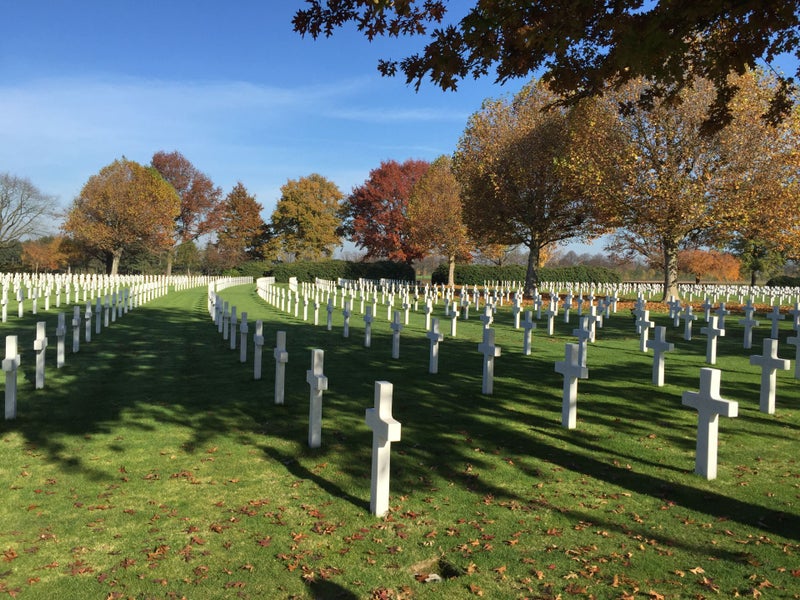
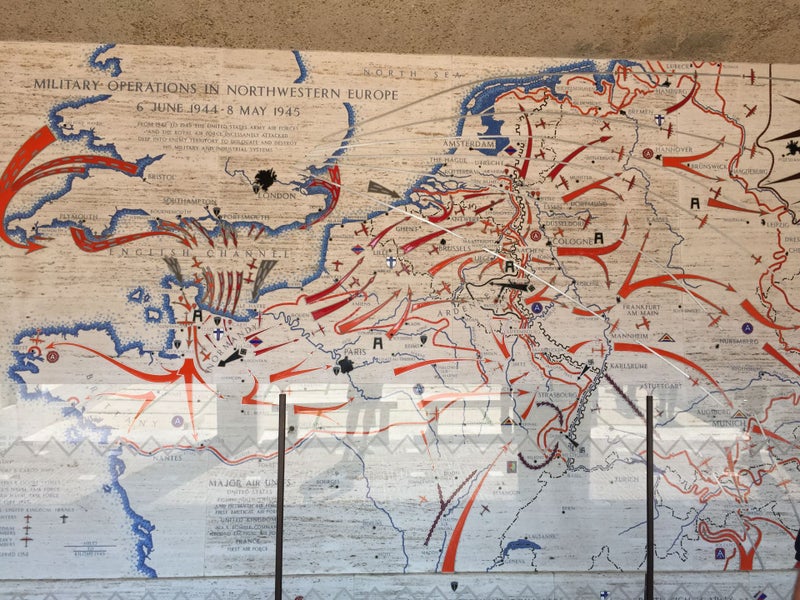


30 March 1946
17742 Americans 1026 other Allied Soldiers (witch 700 Russians) and 3075 German at the Enemy cemetery

The original idea to adopt graves of the American liberators came up in February of 1945. To this effect the “Burger Comité Margraten” (Citizens Committee Margraten) was formed. The committee’s goal was to support the set-up of the American Cemetery with an extensive adoption campaign. The adopters were supposed to regularly visit the adopted grave and, in case this was appreciated, keep in touch with the next of kin in the U.S.
The campaign gained massive support. At the first Memorial Day in 1945 every grave was decorated with flowers. At the second Memorial Day one year later all graves (at the time an incredible amount of 18,764) had been adopted. Captain Shomon, the founder of the American Cemetery, praised the members of the committee for all the work they had done.
The “Citizens Committee Margraten” is partially responsible for the correspondence that developed between the adopters and the descendants of the fallen soldiers. It often resulted in connections and friendships that have survived to this day. Due to the ageing of the members of the Citizens Committee and to the arrival of new means of information and communications, the committee’s work was taken over by the specially formed “Foundation for Adopting Graves at the American Cemetery in Margraten”. The new foundation is mainly staffed by persons who are part of Margraten-Eijsden’s social and economic network. Its intention is to carry on the activities of the former citizens committee in the best possible way.



Notable burials
The Medal of Honor is the highest award for valor in action against an enemy force which can be bestowed upon an individual serving in the Armed Services of the United States. Generally presented to its recipient by the President of the United States of America in the name of Congress, it is often called the Congressional Medal of Honor. There are 6 Medal of Honor recipients buried at the Margraten cemetery. They are:


Lt. Col. Robert G. Cole
101st Airborne division, 502th PIR, 3rd Bat.
Grave : B - 15 - 27
Citation:
For gallantry and intrepidity at the risk of his own life, above and beyond the call of duty on 11 June 1944, in France. Lt. Col. Cole was personally leading his battalion in forcing the last 4 bridges on the road to Carentan when his entire unit was suddenly pinned to the ground by intense and withering enemy rifle, machinegun, mortar, and artillery fire placed upon them from well-prepared and heavily fortified positions within 150 yards of the foremost elements. After the devastating and unceasing enemy fire had for over 1 hour prevented any move and inflicted numerous casualties, Lt. Col. Cole, observing this almost hopeless situation, courageously issued orders to assault the enemy positions with fixed bayonets. With utter disregard for his own safety and completely ignoring the enemy fire, he rose to his feet in front of his battalion and with drawn pistol shouted to his men to follow him in the assault. Catching up a fallen man's rifle and bayonet, he charged on and led the remnants of his battalion across the bullet-swept open ground and into the enemy position. His heroic and valiant action in so inspiring his men resulted in the complete establishment of our bridgehead across the Douve River. The cool fearlessness, personal bravery, and outstanding leadership displayed by Lt. Col. Cole reflect great credit upon himself and are worthy of the highest praise in the military service.
Lt. Col Robert Cole was the only one of the six MOH-recipiënts buried at Margraten to
survive his MOH winning action.
He later was killed at September 18, 1944 in The Netherlands during operation Market-Garden.
PFc. Willy F. James jr.
104st Infantry division, 413th Infantry
Grave : P - 9 - 9
Citation:
For extraordinary heroism in action on 7 April 1945 near Lippoldsberg, Germany. As lead scout during a maneuver to secure and expand a vital bridgehead, Private First Class James was the first to draw enemy fire. He was pinned down for over an hour, during which time he observed enemy positions in detail. Returning to his platoon, he assisted in working out a new plan of maneuver. He then led a squad in the assault, accurately designating targets as he advanced, until he was killed by enemy machine gun fire while going to the aid of his fatally wounded platoon leader. Private First Class James' fearless, self-assigned actions, coupled with his diligent devotion to duty exemplified the finest traditions of the Armed Forces.
No African American soldier was awarded the Medal of Honor during World War II. In 1993 the Army contracted Shaw University in Raleigh, North Carolina, to research and prepare a study "to determine if there was a racial disparity in the way Medal of Honor recipients were selected." Shaw's team researched the issue and, finding that there was disparity, recommended the Army consider a group of 10 soldiers for the Medal of Honor. Of those 10, seven were recommended to receive the award. In October of 1996 Congress passed the necessary legislation which allowed the President to award these Medals of Honor since the statutory limit for presentation had expired. The Medals of Honor were presented, by President William Clinton, in a ceremony on 13 January 1997. Vernon Baker was the only recipient still living and present to receive his award; the other six soldiers received their awards posthumously, with their medals being presented to family members. Willy F. James jr. was one of them.
Pvt. George J. Peters
17th Airborne division, 507th PIR, G-Co.
Grave : G - 17 - 8
Citation:
Pvt. Peters, a platoon radio operator with Company G, made a descent into Germany near Fluren, east of the Rhine. With 10 others, he landed in a field about 75 yards from a German machinegun supported by riflemen, and was immediately pinned down by heavy, direct fire. The position of the small unit seemed hopeless with men struggling to free themselves of their parachutes in a hail of bullets that cut them off from their nearby equipment bundles, when Pvt. Peters stood up without orders and began a l-man charge against the hostile emplacement armed only with a rifle and grenades. His single-handed assault immediately drew the enemy fire away from his comrades. He had run halfway to his objective, pitting rifle fire against that of the machinegun, when he was struck and knocked to the ground by a burst. Heroically, he regained his feet and struggled onward. Once more he was torn by bullets, and this time he was unable to rise. With gallant devotion to his self-imposed mission, he crawled directly into the fire that had mortally wounded him until close enough to hurl grenades which knocked out the machinegun, killed 2 of its operators, and drove protecting riflemen from their positions into the safety of a woods. By his intrepidity and supreme sacrifice, Pvt. Peters saved the lives of many of his fellow soldiers and made it possible for them to reach their equipment, organize, and seize their first objective.
Ssgt. George Peterson
1st Infantry division, 18th Infantry, K-Co
Grave : D - 21 - 10
Citation:
He was an acting platoon sergeant with Company K, near Eisern, Germany. When his company encountered an enemy battalion and came under heavy small-arms, machinegun, and mortar fire, the 2d Platoon was given the mission of flanking the enemy positions while the remaining units attacked frontally. S/Sgt. Peterson crept and crawled to a position in the lead and motioned for the 2d Platoon to follow. A mortar shell fell close by and severely wounded him in the legs, but, although bleeding and suffering intense pain, he refused to withdraw and continued forward. Two hostile machineguns went into action at close range. Braving this grazing fire, he crawled steadily toward the guns and worked his way alone to a shallow draw, where, despite the hail of bullets, he raised himself to his knees and threw a grenade into the nearest machinegun nest, silencing the weapon and killing or wounding all its crew. The second gun was immediately turned on him, but he calmly and deliberately threw a second grenade which rocked the position and killed all 4 Germans who occupied it. As he continued forward he was spotted by an enemy rifleman, who shot him in the arm. Undeterred, he crawled some 20 yards until a third machinegun opened fire on him. By almost superhuman effort, weak from loss of blood and suffering great pain, he again raised himself to his knees and fired a grenade from his rifle, killing 3 of the enemy guncrew and causing the remaining one to flee. With the first objective seized, he was being treated by the company aid man when he observed 1 of his outpost men seriously wounded by a mortar burst. He wrenched himself from the hands of the aid man and began to crawl forward to assist his comrade, whom he had almost reached when he was struck and fatally wounded by an enemy bullet. S/Sgt. Peterson, by his gallant, intrepid actions, unrelenting fighting spirit, and outstanding initiative, silenced 3 enemy machineguns against great odds and while suffering from severe wounds, enabling his company to advance with minimum casualties.
Pfc. Walter C. Wetzel
8st Infantry division, 13th Infantry, AT-Co.
Grave : N - 18 - 10
Citation:
Pfc. Wetzel, an acting squad leader with the Antitank Company of the 13th Infantry, was guarding his platoon's command post in a house at Birken, Germany, during the early morning hours of 3 April 1945, when he detected strong enemy forces moving in to attack. He ran into the house, alerted the occupants and immediately began defending the post against heavy automatic weapons fire coming from the hostile troops. Under cover of darkness the Germans forced their way close to the building where they hurled grenades, 2 of which landed in the room where Pfc. Wetzel and the others had taken up firing positions. Shouting a warning to his fellow soldiers, Pfc. Wetzel threw himself on the grenades and, as they exploded, absorbed their entire blast, suffering wounds from which he died. The supreme gallantry of Pfc. Wetzel saved his comrades from death or serious injury and made it possible for them to continue the defense of the command post and break the power of a dangerous local counterthrust by the enemy. His unhesitating sacrifice of his life was in keeping with the U.S. Army's highest traditions of bravery and heroism.
1Lt. Walter J. Will
1st Infantry division, 18th Infantry, K-Co
Grave : D - 3 - 32
Citation:
He displayed conspicuous gallantry during an attack on powerful enemy positions. He courageously exposed himself to withering hostile fire to rescue 2 wounded men and then, although painfully wounded himself, made a third trip to carry another soldier to safety from an open area. Ignoring the profuse bleeding of his wound, he gallantly led men of his platoon forward until they were pinned down by murderous flanking fire from 2 enemy machineguns. He fearlessly crawled alone to within 30 feet of the first enemy position, killed the crew of 4 and silenced the gun with accurate grenade fire. He continued to crawl through intense enemy fire to within 20 feet of the second position where he leaped to his feet, made a lone, ferocious charge and captured the gun and its 9-man crew. Observing another platoon pinned down by 2 more German machineguns, he led a squad on a flanking approach and, rising to his knees in the face of direct fire, coolly and deliberately lobbed 3 grenades at the Germans, silencing 1 gun and killing its crew. With tenacious aggressiveness, he ran toward the other gun and knocked it out with grenade fire. He then returned to his platoon and led it in a fierce, inspired charge, forcing the enemy to fall back in confusion. 1st Lt. Will was mortally wounded in this last action, but his heroic leadership, indomitable courage, and unflinching devotion to duty live on as a perpetual inspiration to all those who witnessed his deeds.
In this same action SSgt. George Peterson earned his MOH.
Adopting graves at the Netherlands American Cemetery and Memorial Margraten
Originally the Cemetery was designated to the US Ninth Army. At first the 611th Graves Registration Company, led by Captain Joseph James Shomon planned a location near the city of Sittard. But at the time Sittard was situated at the front line. When Shomon started his preparations for the Cemetery his company was shot at by American and German units alike. So soon he was forced to look out for another location.
After some cross country reconnaissance their attention was drawn to a field near the village of Margraten. There Shomon contacted Joseph van Laar, who later played a very important role in what became known as the local adoption tradition. After Shomon had uttered his final and convincing statement : ‘ Listen Joe, the best soil is not good enough for our boys’, the decision making had been concluded and Margraten was definitely designated as the area for the Ninth Army Military Cemetery.
In November 1944 the actual work in the field started. On november 10 the first soldier was buried at Plot A, Row 1, Grave 1. At this time the fallen soldiers were buried in a linen bag accompanied by a brief ceremonial. Soon 19.000 soldiers were laid at rest at the Cemetery. The year 1944 had the coldest winter in years, comparable to a Siberian winter, so the circumstances under which the ‘diggers’ (the all-black 3136th Quartermaster Service company) had to do their work were the harshest imaginable. The ‘headstones’ were constructed of simple wooden crosses with the soldier’s tag attached to it. A year later these crosses beared the soldiers name and his Service number. At the end of the fourties the soldiers were reburied and their remains were placed in a coffin made of steel and bronze innerworks. The next of kin in the U.S. were offered the opportunity to bring the body of their beloved son, brother or father back to the States to be buried at home. Many American families made the soulsearching decision not to bring back their beloved to the United States, considering that it was their beloved last wish to be buried next to his comrades. More than 11.000 soldiers were brought back to their homeland and 8300 stayed at Margraten. At that time the present-day marble headstones were placed along with the Court of Honor and the Chapel
In the waning days of World War II, a couple of months after the southern part of the Dutch Province of Limburg had been liberated by American units, a small Margraten civil committee picked up the idea of adopting graves at the Cemetery, after Joseph van Laar had been asked by a Captain Lane to watch out for the grave of Captain Lane’s nephew John Land. A growing number of American soldiers asked Joseph van Laar to visit a friend’s grave every now and then. The committee soon had set up the complete register for the adoption of all the graves at the Ninth Army Military Cemetery.
When the new cemetery marked its first Memorial Day, Dutch citizens from 60 local villages collected 20 truckloads of flowers so that every American grave would be decorated on Memorial Day.
By 1946 thousands of local, and later from all over the Netherlands, people volunteered.
In 2003 the task of the committee was handed over to the Foundation Adoption Graves American Cemetery Margraten. This foundation is still working on the revision of the adoption register. Nowadays younger generations are taking over the honour of taking care of one or more graves.
The adoption means:
- visiting the grave; the frequency is determined by the caretaker
- placing of flowers on special days or occasions (like e.g. Memorial Day or Christmas)
- when relatives wish to do so, corresponding with the homeland
As an allowance for the foundation’s administration, people are asked to donate once-only a minimum contribution of 7.50 Euro.
Parents can pass on the adoption to their children, but are kindly entreated to forward any change (like changes of address or death notices) which could be of importance to the adoption register.
For more information you can visit the foundation’s web-site at www.adoptiegraven-margraten.nl.
The Foundation Adoption Graves American Cemetery Margraten also offers the opportunity to order the book "Crosses in the Wind" (in English or Dutch), written by Captain Joseph James Shomon.
If you are interested in adopting a grave at the Netherlands American Cemetery and Memorial Margraten, please visit the site of the Foundation Adoption Graves American Cemetery Margraten.
You can find also a lott of information at following website these is written in Dutch an English language
http://www.akkersvanmargraten.nl/
https://www.abmc.gov/cemeteries-memorials/europe/netherlands-american-cemetery#.V9Pl5piLQdU
http://www.svaao.nl/index.php/nl/
http://www.margratenmemorialcenter.org/margraten/
http://www.fallennotforgotten.nl/










